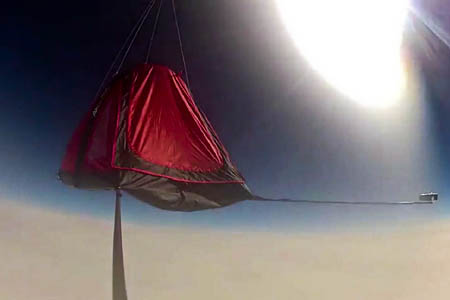Perhaps it’s something in the air, but the team at Scottish outdoor brand Vango went stratospheric with their latest jaunt: space camping.
The Port Glasgow-based squad launched one of their Vango AirBeam tents into space, complete with a diminutive crew of four animated Vangonauts into the sky above the Scottish Highlands.
The space tent reached an altitude three-and-a-half times the height of Everest before returning to earth after its helium-filled latex balloon popped in the low pressure of the stratosphere, 31,500m above the Scottish hills.
On its serene flight upwards, the red Vango AirBeam Flux 200 can be seen surreally floating above the Highland topography then through a hail and snow storm before clearing the clouds and bursting into sunlight.
Vango said the AirBeam was launched from its Camp Canaveral base near Oban. The tent, and its crew engineer Herman Vortex, Captain Alex Infinity, Field Officer Peter Flux and navigator Jill Kasari, who according to the company trained for more than eight months in super-cold temperatures and reduced-oxygen rooms in order to prepare and acclimatise themselves to space altitude levels, covered almost 70km before its re-entry near Loch Tay.
The whole thing was recorded in high definition and a YouTube documentary shows the launch, flight and the recovery of the crew.
Vango has also posted the full 30-minute flight film with footage of the AirBeam’s ascent and descent.
The company said: “Take off went smoothly, minus a dip on take-off, with weather conditions being typical Scottish showers, and a snow storm during descent.
“GPS locators fitted to the command module broadcast a data package every eight minutes, allowing the team on the ground to predict the landing location, which was 70 miles away from base camp.
“Local air-traffic controllers and the Civil Aviation Authority were notified well in advance of the flight and were onboard with the VASA [Vango Association of Space Accommodation] space tourism mission.
“The mission landed in wilderness near Loch Tay resulting in a 10km hike through snow, hail and bogs for the ground crew to rendezvous with the intrepid campers.
“It is hoped that in future Space Camping missions, less remote landings can be orchestrated for the convenience of the campers.”
The mission took place this month.
Gary Craig, VASA project director, said: “Camping has always been an egalitarian means to venture, explore and enjoy the great outdoors.
“Outer space should be no exception. Project Space Camping will change the face of camping holidays and give everybody who wants to a chance to take off and be part of something incredible.
“We want space to be accessible to all, and what better way to see the world than through a Vango AirBeam tent window.”
VASA’s advice to would-be space campers on the moon, which they said they hoped to see before the decade is out, is: pack light; wear good sunscreen and take spare camera batteries.
Vango AirBeam tents use inflatable beams in place of traditional metal poles for rapid pitching in any environment. Pitching time takes between three and 10 minutes depending on the tent size.
